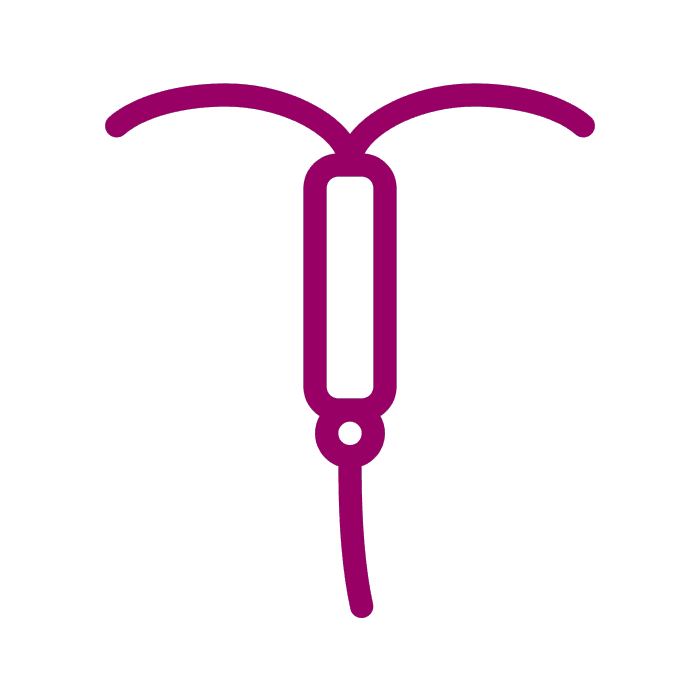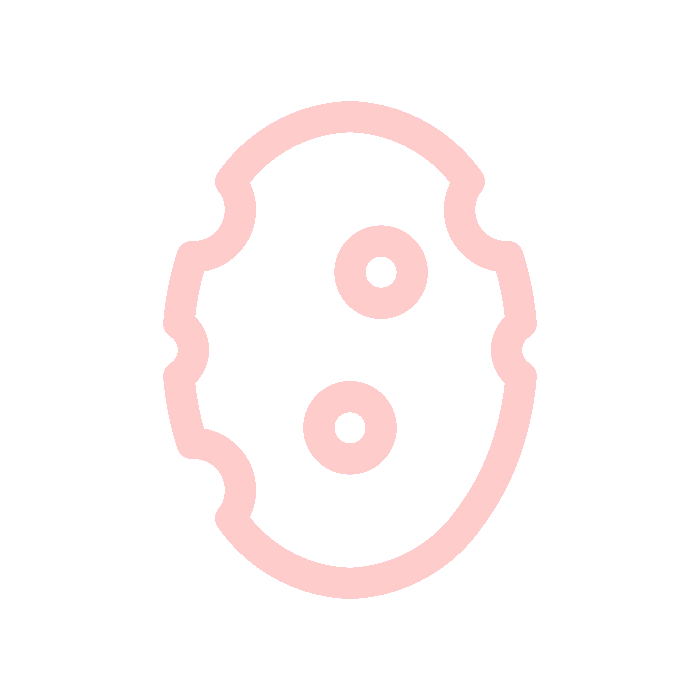
INTRAUTERINE DEVICE - IUD
Intrauterine Method
An IUD is a small, flexible, often T-shaped device wrapped in copper placed inside your womb by your healthcare provider.
99 % Effective
Details
The intrauterine contraceptive device (IUD) is a small, flexible plastic frame with copper sleeves or wire around it that is inserted into your womb by a trained healthcare professional. The copper makes it more difficult for sperm to reach an egg and survive. It can also stop a fertilised egg from implanting itself.
It is more than 99% effective in preventing pregnancy, and it lasts for 5 to 10 years, depending on the type.
How to
An IUD needs to be fitted by a trained healthcare professional. The appointment takes about 20 to 30 minutes and fitting the IUD should take no longer than 5 minutes. Having an IUD fitted can be uncomfortable, and some people might find it painful. Some women get period-type cramps afterwards, but you can use painkillers to ease the cramps. You may also bleed for a few days after having an IUD fitted.
You can have your IUD removed at any time by a healthcare professional. As you can get pregnant as soon as the IUD has been taken out, use additional contraception, such as condoms.
Pros
IUDs are more than 99% effective when inserted correctly
It protects against pregnancy for 5 or 10 years, depending on the type
It is suitable for women who want to avoid having to remember to take contraceptive pills or injections, and who want a long-acting, reversible contraceptive method.
There are no hormonal side effects, such as acne, headaches or breast tenderness.
It does not interrupt sex
Cons
Some women may have heavier, longer or more painful periods, though this may improve after a few months.
Some women may have spotting or bleeding between periods.
There’s a small risk of getting an infection after the IUD is fitted.
It does not protect you against sexually transmitted infections (STIs), such as HIV), so you may need to use condoms as well
Side Effects
You may experience:
Changes in your monthly bleeding patterns, including:
Lighter bleeding and fewer days of bleeding
Irregular bleeding
Infrequent bleeding
No monthly bleeding
Periods that last longer
These changes in bleeding are normal and are not harmful. If you find them bothersome, speak to your healthcare professional.
Headaches
Dizziness
Nausea
Painful and tender breasts
Weight gain
Mood changes
Acne
There is an increased risk of ovarian cysts
Frequently Asked Questions
-
An IUD is a small T-shaped plastic and copper device that's put into your womb (uterus) by a doctor or nurse.
It releases copper to stop you from getting pregnant, and protects against pregnancy for between 5 and 10 years. It's sometimes called a "coil" or "copper coil".
-
An IUD (Intrauterine Device) insertion is usually well tolerated by most women. Local anaesthesia may be applied to the uterine cervix before the insertion. Some women may experience pain and dizziness after insertion, which usually settles after resting for a short time.
-
The IUD can be used as emergency contraception and must be inserted within 5 to 8 days (ideally within 120 hours) after unprotected sex. Because of the insertion procedure, the IUD is not suitable to be used regularly as emergency contraception.
-
Neither you nor your partner should feel the IUD during sexual intercourse. If you do, sexual intercourse should be avoided until your doctor has checked that the IUD is still in the correct position.
-
The IUD must be inserted by a trained healthcare provider who will follow the necessary procedure to ensure it is correctly positioned. Occasionally, the muscular contractions of the womb during menstruation may sometimes push it out of place or expel it. Very rarely it can perforate the wall of the uterus. If a user of an IUD experiences any unusual bleeding, pain or discomfort, the doctor must be informed as soon as possible.
-
Use of sanitary pads is recommended. If tampons are used, you should change them more frequently, and with care so as not to pull the threads of the IUD when manipulating the tampon.















CONTRACEPTIVE METHODS
CONTRACEPTIVE METHODS
-

CONTRACEPTIVE IMPLANT
1 or 2 small hormone-releasing silicone rods placed under the skin by a healthcare provider.
-

CONTRACEPTIVE INJECTION
The contraceptive injection is a shot of hormones that lasts for 1 up to 3 months.
-

CONTRACEPTIVE PATCH
A patch that sticks to the skin and releases hormones that are highly effective at stopping pregnancy.
-

CONTRACEPTIVE RING
A flexible plastic ring that is placed in the vagina by the woman and constantly releases hormones.
-

DIAPHRAGM
A diaphragm is a small dome that blocks the entrance to the cervix to stop sperm from entering the womb.
-

EMERGENCY CONTRACEPTIVES
Emergency contraceptives are hormone-based pills that are used in the event of accidental unprotected sex.
-

FEMALE CONDOM
A female condom is a sheath that is placed inside a woman’s vagina before sexual intercourse.
-

FERTILITY AWARENESS
Fertility awareness is the method of only having sex on the non-fertile days of your menstrual cycle.
-

INTRAUTERINE SYSTEM-IUS
An IUS is a small, flexible, T-shaped system that releases low levels of hormones and is placed inside the womb by your healthcare provider.
-

MALE CONDOM
A condom is a thin film sheath that is placed over a man’s erect penis before having sex.
-

PULL-OUT METHOD
Pulling out (also called Withdrawal Method) requires no additional hormones or devices, just impeccable timing and a lot of luck.
-

SPERMICIDES
Spermicides affect the way sperm travels in the womb making it hard for them to move freely and fertilize an egg.
-

SPONGE
A sponge blocks the entrance to the cervix and releases spermicide, both together stopping sperm from entering the womb and fertilizing an egg.
-

STERILISATION
Sterilisation is the process of completely taking away the body’s ability to reproduce through surgery or minimal invasion.
-

THE PILL
The pill is a small tablet containing hormones that must be swallowed every day, at the same time.



